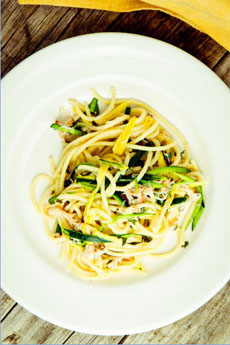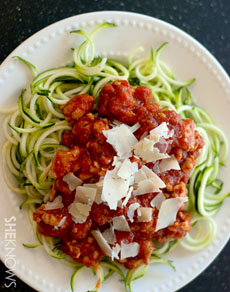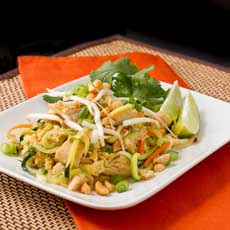TIP OF THE DAY: The Pasta For Summer, Zucchini “Pasta,” Enhanced
|
August 8th is National Zucchini Day. Last year, we featured the Spiralizer, a gadget that started the zucchini noodle craze by making it easy to make long pasta-like strands from firm vegetables, along with a recipe for Zucchini Pasta With Crab. The concept took off in the media and in kitchens across the country. Who wouldn’t like a better-for-you pasta experience? At 20 calories per cup of zucchini and 40 calories for a half cup of tomato sauce, one could have a big plate of “pasta” of better-for-you complex carbs for 100 calories—including the grated Parmesan. Some people, though, still longed for the toothsome texture and flavor of Italian pasta. So today’s tip is: Mix the two noodles together: half standard pasta noodles (wheat) and half zucchini noodles. The concept is very versatile: the combination of starch and vegetable lends itself to many more sauces than standard pasta sauces. You can use any pasta sauce, or turn to global cuisines for another approach. Asian sauces work particularly well here, but there are plenty of other options including: Match the zucchini size to the pasta size you buy, e.g., linguine (thin) or pappardelle (wide). Also check out our recipe for mixed zucchini and pasta noodles with crab. |

|
|
|
1. BRING a pot of salted water to a rolling boil. Add the wheat noodles and cook for 7 to 10 minutes or until tender. SCOOP the noodles out with a mesh strainer, reserving the water; add them to a large bowl and set aside. 2. ADD the zucchini noodles to the water and bring to a boil. Lower to a simmer and test after 5 minutes. Do not overcook. When ready, drain, reserving a bit of the pasta water and add to the wheat noodles. Stir to combine. 3. HEAT the oil in a large skillet over medium heat. Add the garlic and cook for 2 minutes, until tender. 3. WHISK the eggs lightly with a fork or mini-whisk; add them to the skillet and lightly scramble. Cook the eggs until they just solidify but are still moist. Remove the skillet from the heat and set aside on a trivet or other counter protector. 4. MAKE the sauce: In a small bowl combine the soy sauce, lime juice, sugar, fish sauce and red pepper flakes. Add the sauce into the scrambled eggs in the skillet. Pour/scrape into the noodle bowl and toss to coat. At this point, if you want to serve the dish hot or warm, microwave briefly before adding the garnishes. 5. ADD the green onions, cilantro, and peanuts over the noodles. Toss lightly to combine and serve. |
||
 Beyond zucchini, the WonderVeg Spiralizer can transform any hard vegetable into long strands for “pasta” or for raw vegetable salads and garnish. Consider beet, carrot, cucumber, turnip and zucchini, plus others such as green papaya (photo courtesy WonderVeg.com). |
ZUCCHINI HISTORY Zucchini, Cucurbita pepo, is a member of the cucumber and melon family, Cucurbitaceae. It originated in Central and South America, where it has been consumed for thousands of years. It grew in different shapes, including round balls that can still be grown from heirloom seeds. But the variety most of us are familiar with was developed at the end of the 19th century near Milan, Italy. The word squash comes from Narraganset language of the Native Americans of Rhode Island, who used askutasquash, “a green thing eaten raw. The Pilgrims had difficulty pronouncing the whole word, and shortened it to squash. Either way, it was an extremely valuable source of food for both peoples, and one that we also heavily rely on as a source of nutrition for a large part of the season. The word zucchini comes from the Italian zucchino, meaning a small squash (zucca is the word for pumpkin). In the wonderful world of food fusion, the word squash comes from the Indian skutasquash meaning “green thing eaten green.” Christopher Columbus originally brought seeds to the Mediterranean region and Africa. |
|
|
The French turned their noses up at zucchini (courgettes) for a long time until cooks learned to choose small fruits, which are less bland and watery. The same tip still applies: the smaller, the better. While a botanical fruit*, zucchini is treated as a vegetable. With the exception of zucchini bread and zucchini muffins, both made with sugar, it is typically cooked as a savory dish or accompaniment. has its ancestry in the Americas. However, the varieties of squash typically called “zucchini” were developed in Italy, many generations after their introduction from the Americas. |
||


